Transmission Replacement RPOs LZE/LZ9
Tools Required
J 37096 Flywheel Holder
Removal Procedure
- Disconnect the negative battery cable. Refer to Battery Negative Cable Disconnection and Connection .
- Remove the intake manifold cover. Refer to Intake Manifold Cover Replacement for the 3.5L engine, or Intake Manifold Cover Replacement for the 3.9L engine.
- Remove the air cleaner outlet duct. Refer to Air Cleaner Outlet Duct Replacement for the 3.5L engine, or Air Cleaner Outlet Duct Replacement for the 3.9L engine.
- Disconnect the wiring harness electrical connectors.
- Remove the transaxle range selector cable from the transaxle shift lever.
- Remove the transaxle range selector cable retainer from the cable.
- Remove the transaxle range selector cable from the transaxle.
- Remove the transaxle wiring grounds from the transaxle.
- Remove the upper transaxle bolts (2, 3) and the stud (4).
- Install the engine support fixture to support the engine/transaxle assembly. Refer to Engine Support Fixture for the 3.5L engine, or Engine Support Fixture for the 3.9L engine.
- Raise and support the vehicle. Refer to Lifting and Jacking the Vehicle .
- Remove the front wheels. Refer to Tire and Wheel Removal and Installation .
- Remove the left and the right front fender liners. Refer to Front Fender Liner Replacement .
- Remove the frame from the vehicle. Refer to Frame Replacement .
- Remove the starter motor. Refer to Starter Motor Replacement .
- Install the J 37096 in order to gain access to the torque converter bolts and to prevent the flywheel from turning.
- Remove the torque converter bolts.
- Remove the transaxle oil cooler pipes from the transaxle. Refer to Transmission Fluid Cooler Hose/Pipe Replacement .
- Remove the left and the right wheel drive shafts from the transaxle. Refer to Wheel Drive Shaft Replacement .
- Secure the drive shafts to the steering knuckles.
- Disconnect the vehicle speed sensor electrical connector.
- Position a transmission jack under the transaxle and secure the transmission jack to the transaxle.
- Remove the transaxle brace. Refer to Transmission Brace Replacement .
- Remove the lower transaxle bolt (1, 5).
- Remove the transaxle from the vehicle.
- Transfer all necessary parts as needed.
- Flush the transmission cooler and lines. Refer to Transmission Fluid Cooler Flushing and Flow Test .
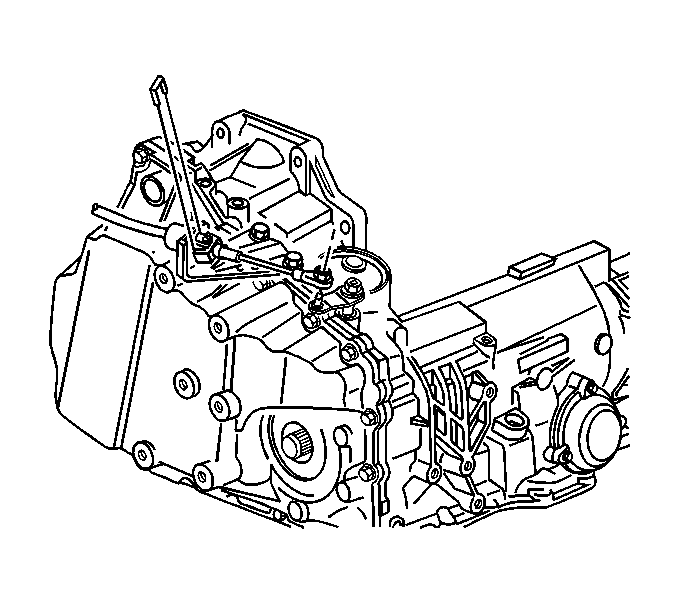
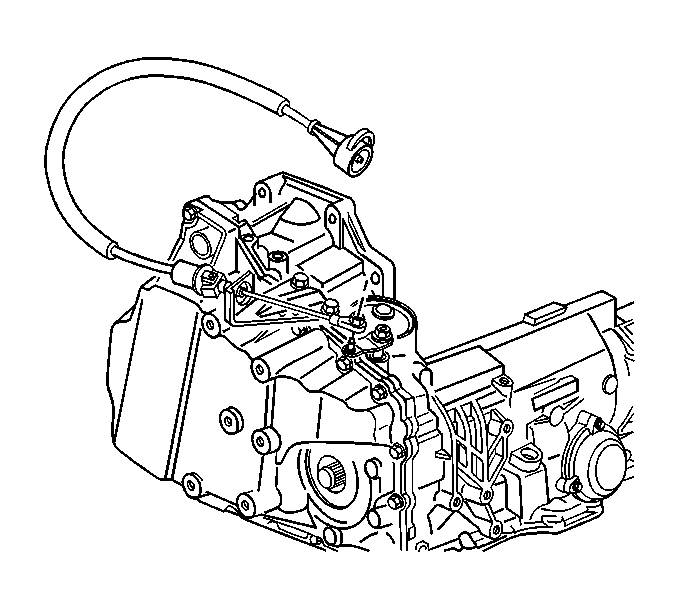
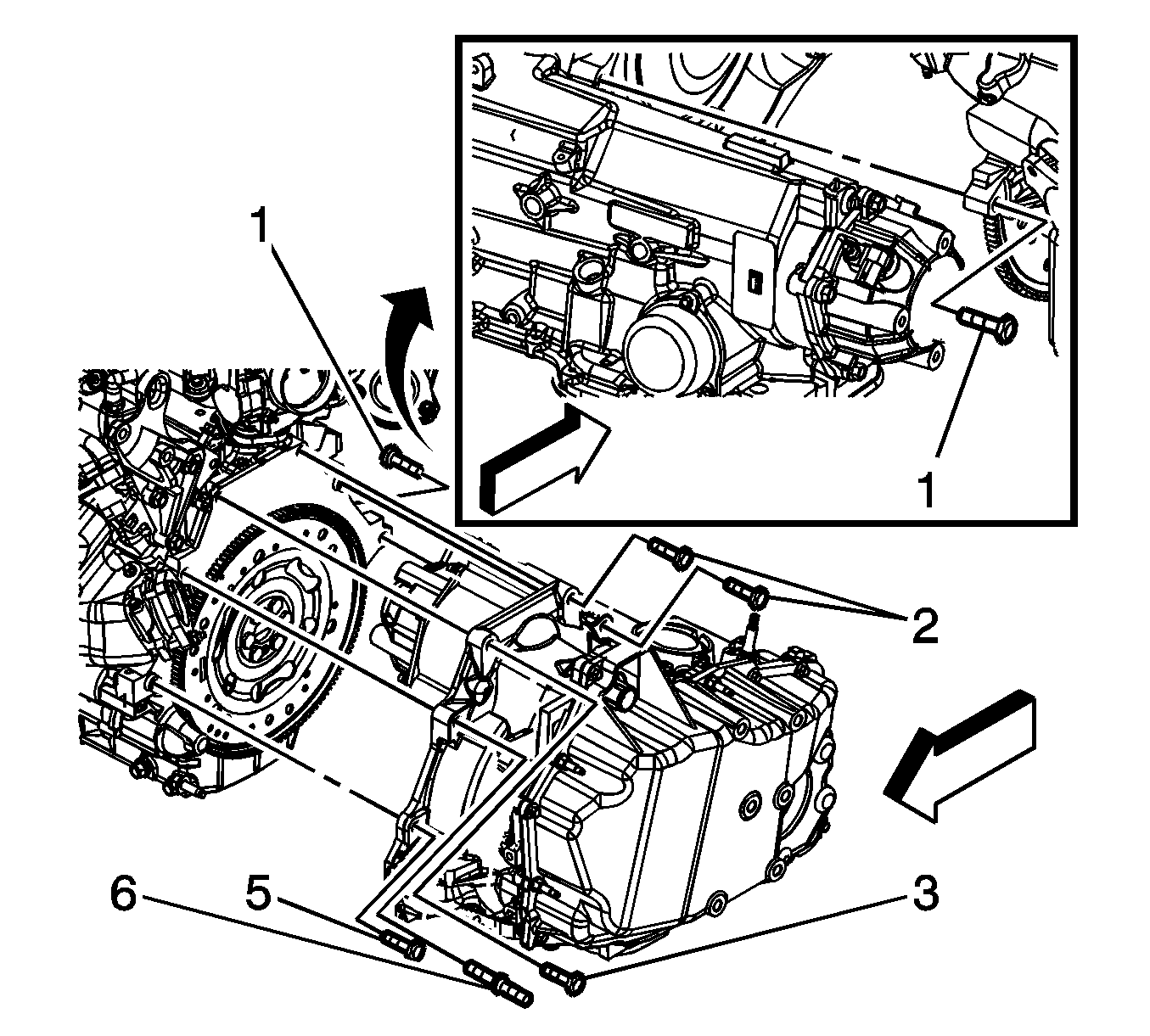
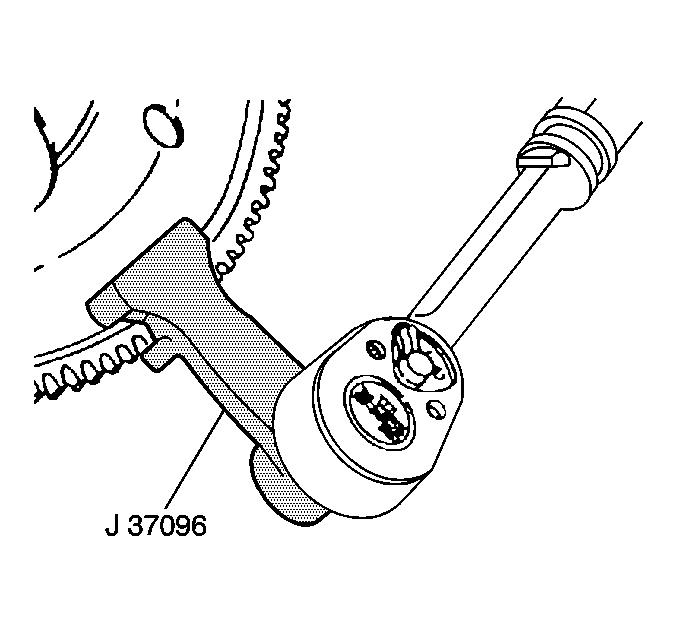
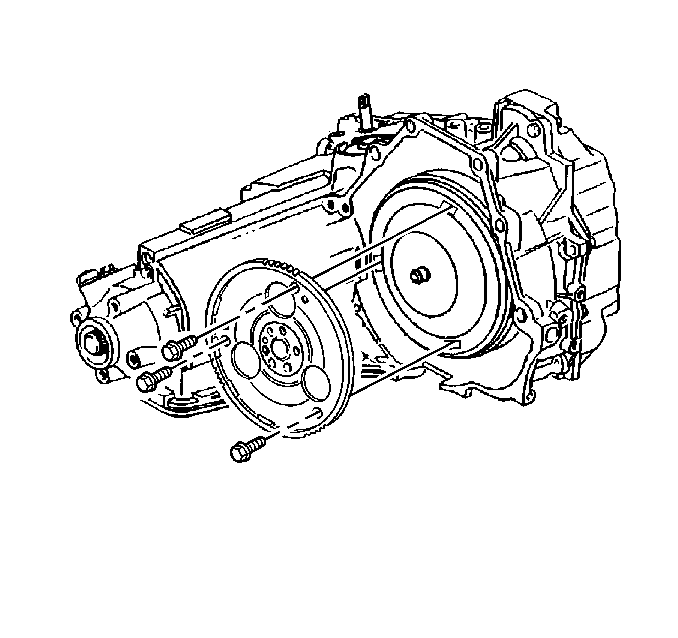
Important: Position and secure the wheel drive shafts out of the way.
Important: Ensure the transmission jack is properly secured to the transaxle.

Installation Procedure
- Position the transaxle onto a transmission jack and secure the transaxle to the transmission jack.
- Install the transaxle into the vehicle.
- Install the lower transaxle bolt (1, 5).
- Install the transaxle brace. Refer to Transmission Brace Replacement .
- Install the J 37096 in order to gain access to the torque converter bolts and to prevent the flywheel from turning.
- Install the torque converter bolts.
- Install the wheel drive shafts into the transaxle. Refer to Wheel Drive Shaft Replacement .
- Install the transaxle oil cooler pipes to the transaxle. Refer to Transmission Fluid Cooler Hose/Pipe Replacement .
- Install the starter motor. Refer to Starter Motor Replacement .
- Install the frame to the vehicle. Refer to Frame Replacement .
- Connect the vehicle speed sensor electrical connector.
- Install the left and the right front fender liners. Refer to Front Fender Liner Replacement .
- Install the front wheels. Refer to Tire and Wheel Removal and Installation .
- Lower the vehicle.
- Remove the engine support fixture.
- Install the upper transaxle bolts (2, 3) and the stud (4).
- Install the transaxle wiring grounds and the nuts.
- Connect the transaxle harness electrical connectors.
- Install the transaxle range selector cable to the transaxle range selector cable bracket.
- Install the automatic transaxle range selector cable retainer to the cable.
- Install the transaxle range selector cable to the transaxle shift lever.
- Install the air induction duct. Refer to Refer to Air Cleaner Outlet Duct Replacement for the 3.5L engine, or Air Cleaner Outlet Duct Replacement for the 3.9L engine.
- Install the intake manifold cover. Refer to Intake Manifold Cover Replacement for the 3.5L engine, or Intake Manifold Cover Replacement for the 3.9L engine.
- Connect the negative battery cable. Refer to Battery Negative Cable Disconnection and Connection .
- Fill the transaxle with automatic transmission fluid.
- Inspect for automatic transmission fluid leaks. Refer to Fluid Leak Diagnosis .
- Reset the TAP values. Refer to Transmission Adaptive Functions .
Important: Ensure the transaxle is secured properly to the transmission jack.
Notice: Refer to Fastener Notice in the Preface section.

Tighten
Tighten the bolts to 75 N·m (55 lb ft).


Tighten
Tighten the bolts to 63 N·m (46 lb ft).

Tighten
Tighten the bolts and the stud to 75 N·m (55 lb ft).
Tighten
Tighten the nuts to 45 N·m (33 lb ft).


Notice: Refer to Transmission Overfill Notice in the Preface section.
Important: It is recommended that the transmission adaptive pressure (TAP) information be reset. Resetting the TAP values using a scan tool will erase all learned values in all cells. As a result, the ECM, PCM or TCM will need to relearn TAP values. Transmission performance may be affected as new TAP values are learned.
Transmission Replacement RPO LS4
Special Tools
J 37096 Flywheel Holder
Removal Procedure
- Disconnect the negative battery cable. Refer to Battery Negative Cable Disconnection and Connection .
- Remove the engine sight shield. Refer to Upper Intake Manifold Sight Shield Replacement .
- Remove the air cleaner outlet duct. Refer to Refer to Air Cleaner Resonator Outlet Duct Replacement .
- Remove the exhaust crossover pipe. Refer to Exhaust Crossover Pipe Replacement .
- Disconnect the wiring harness electrical connectors.
- Remove the transaxle range selector cable from the transaxle shift lever.
- Remove the transaxle range selector cable retainer from the cable.
- Remove the transaxle range selector cable from the transaxle.
- Remove the transaxle wiring grounds from the transaxle.
- Remove the upper transaxle bolts (2).
- Install the engine support fixture to support the engine/transaxle assembly. Refer to Engine Support Fixture .
- Raise and support the vehicle. Refer to Lifting and Jacking the Vehicle .
- Remove the front wheels. Refer to Tire and Wheel Removal and Installation .
- Remove the left and the right front fender liners. Refer to Front Fender Liner Replacement .
- Remove the frame from the vehicle. Refer to Frame Replacement .
- Remove the starter motor. Refer to Starter Motor Replacement .
- Install the J 37096 in order to gain access to the torque converter bolts and to prevent the flywheel from turning.
- Remove the torque converter bolts.
- Remove the transaxle oil cooler pipes from the transaxle. Refer to Transmission Fluid Cooler Hose/Pipe Replacement .
- Remove the left and the right wheel drive shafts from the transaxle. Refer to Wheel Drive Shaft Replacement .
- Secure the drive shafts to the steering knuckles.
- Disconnect the vehicle speed sensor electrical connector.
- Position a transmission jack under the transaxle and secure the transmission jack to the transaxle.
- Remove the transaxle brace. Refer to Transmission Brace Replacement .
- Remove the lower transaxle bolt (1) and the stud (3).
- Remove the transaxle from the vehicle.
- Transfer all necessary parts as needed.
- Flush the transmission cooler and lines. Refer to Transmission Fluid Cooler Flushing and Flow Test .


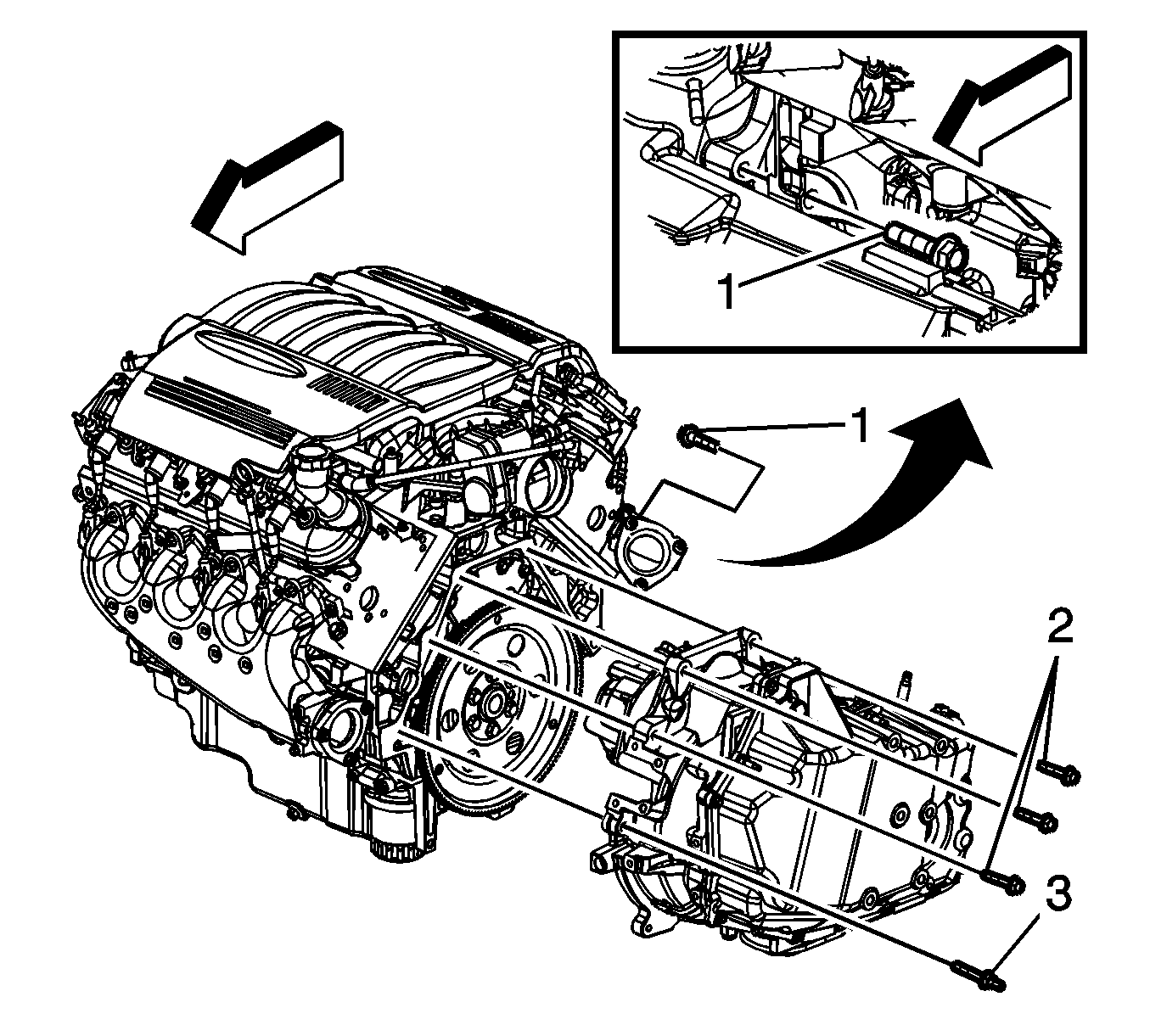


Important: Position and secure the wheel drive shafts out of the way.
Important: Ensure the transmission jack is properly secured to the transaxle.

Installation Procedure
- Position the transaxle onto a transmission jack and secure the transaxle to the transmission jack.
- Install the transaxle into the vehicle.
- Install the lower transaxle bolt (1) and the stud (3).
- Install the transaxle brace. Refer to Transmission Brace Replacement .
- Install the J 37096 in order to gain access to the torque converter bolts and to prevent the flywheel from turning.
- Install the torque converter bolts.
- Install the wheel drive shafts into the transaxle. Refer to Wheel Drive Shaft Replacement .
- Install the transaxle oil cooler pipes to the transaxle. Refer to Transmission Fluid Cooler Hose/Pipe Replacement .
- Install the starter motor. Refer to Starter Motor Replacement .
- Install the frame to the vehicle. Refer to Frame Replacement .
- Connect the vehicle speed sensor electrical connector.
- Install the left and the right front fender liners. Refer to Front Fender Liner Replacement .
- Install the front wheels. Refer to Tire and Wheel Removal and Installation .
- Lower the vehicle.
- Remove the engine support fixture.
- Install the upper transaxle bolts (2).
- Install the transaxle wiring grounds and the nuts.
- Connect the transaxle harness electrical connectors.
- Install the transaxle range selector cable to the transaxle range selector cable bracket.
- Install the automatic transaxle range selector cable retainer to the cable.
- Install the transaxle range selector cable to the transaxle shift lever.
- Install the air induction duct. Refer to Refer to Air Cleaner Resonator Outlet Duct Replacement .
- Install the exhaust crossover pipe. Refer to Exhaust Crossover Pipe Replacement .
- Install the engine sight shield. Refer to Upper Intake Manifold Sight Shield Replacement .
- Connect the negative battery cable. Refer to Battery Negative Cable Disconnection and Connection .
- Fill the transaxle with automatic transmission fluid.
- Inspect for automatic transmission fluid leaks. Refer to Fluid Leak Diagnosis .
- Reset the TAP values. Refer to Transmission Adaptive Functions .
Important: Ensure the transaxle is secured properly to the transmission jack.
Notice: Refer to Fastener Notice in the Preface section.

Tighten
Tighten the bolt and the stud to 75 N·m (55 lb ft).


Tighten
Tighten the bolts to 63 N·m (46 lb ft).

Tighten
Tighten the bolts and the stud to 75 N·m (55 lb ft).
Tighten
Tighten the nuts to 45 N·m (33 lb ft).


Notice: Refer to Transmission Overfill Notice in the Preface section.
Important: It is recommended that the transmission adaptive pressure (TAP) information be reset. Resetting the TAP values using a scan tool will erase all learned values in all cells. As a result, the ECM, PCM or DTM will need to relearn TAP values. Transmission performance may be affected as new TAP values are learned.
